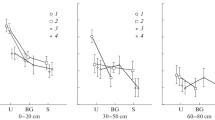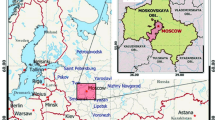Abstract
The number and species diversity of yeasts in urban soils (urbanozems) affected by heating mains and in epiphytic yeast complexes of grasses growing above them were studied. The number of yeasts in the soil reached 103–104 CFU/g; on the plants, 107 CFU/g. Significant (by an order of magnitude) increase in the total number of soil yeasts in the zone of heating mains in comparison with the surrounding soil was found in winter period. Overall, 25 species of yeasts were isolated in our study. Yeast community of studied urbanozems was dominated by the Candida sake, an eurybiont of the temperate zone and other natural ecotopes with relatively low temperatures, but its share was minimal in the zone of heating mains. In general, the structure of soil and epiphytic yeast complexes in the zones of heating mains differed from that in the surrounding area by higher species diversity and a lower share of pigmented species among the epiphytic yeasts. The study demonstrated that the number and species structure of soil yeast communities in urban soils change significantly under the influence of the temperature factor and acquire a mosaic distribution pattern.
Similar content being viewed by others
References
M. I. Gerasimova, M. N. Stroganova, N. V. Mozharova, and T. V. Prokof’eva, Anthropogenic Soils: Genesis, Geography, and Rehabilitation (Oikumena, Smolensk, 2003) [in Russian].
A. M. Glushakova and A. V. Kachalkin, “Endophytic yeasts in Malus domestica and Pyrus communis fruits under anthropogenic impact,” Microbiology (Moscow) 86, 128–135 (2017).
A. M. Glushakova, A. V. Kachalkin, T. M. Zheltikova, and I. Yu. Chernov, “Yeasts associated with wind-pollinated plants—leading pollen allergens in Central Russia,” Microbiology (Moscow) 84, 722–725 (2015).
A. M. Glushakova, A. V. Kachalkin, and I. Yu. Chernov, “Effect of invasive herb species on the structure of soil yeast complexes in mixed forests exemplified by Impatiens parviflora DC,” Microbiology (Moscow) 84, 717–721 (2015).
A. M. Glushakova, A. V. Kachalkin, and I. Yu. Chernov, “The influence of Aster x salignus Willd. invasion on the diversity of soil yeast communities,” Eurasian Soil Sci. 49, 792–795 (2016).
A. M. Glushakova, A. V. Kachalkin, and I. Yu. Chernov, “Soil yeast communities under the aggressive invasion of Sosnowsky’s hogweed (Heracleum sosnowskyi),” Eurasian Soil Sci. 48, 201–207 (2015).
A. M. Glushakova and I. Yu. Chernov, “Seasonal dynamics of the structure of epiphytic yeast communities,” Microbiology (Moscow) 79, 830–839 (2010).
A. M. Glushakova and I. Yu. Chernov, Seasonal dynamic of the numbers of epiphytic yeasts,” Microbiology (Moscow) 76, 590–595 (2007).
T. G. Dobrovol’skaya, D. G. Zvyagintsev, I. Yu. Chernov, A. V. Golovchenko, G. M. Zenova, L. V. Lysak, N. A. Manucharova, O. E. Marfenina, L. M. Polyanskaya, A. L. Stepanov, and M. M. Umarov, “The role of microorganisms in the ecological functions of soils,” Eurasian Soil Sci. 48, 959–967 (2015).
A. V. Kachalkin, A. M. Glushakova, A. M. Yurkov, and I. Yu. Chernov, “Characterization of yeast groupings in the phyllosphere of Sphagnum mosses,” Microbiology (Moscow) 77, 474–481 (2008).
I. A. Maksimova and I. Yu. Chernov, “Community structure of yeast fungi in forest biogeocenoses,” Microbiology (Moscow) 73, 474–481 (2004).
O. E. Marfenina, Anthropogenic Ecology of Soil Fungi (Meditsina dlya Vsekh, Moscow, 2005) [in Russian].
A. K. Cherkashin, Multisystem Modeling (Nauka, Novosibirsk, 2005) [in Russian].
I. Yu. Chernov, Yeasts in Nature (KMK, Moscow, 2013) [in Russian].
I. Yu. Chernov, A. M. Glushakova, and A. V. Kachalkin, “Annotated list of yeast species in Moscow region,” Mikol. Fitopatol. 47 (2), 103–115 (2013).
V. Andreoni, L. Cavalca, M. A. Rao, G. Nocerino, S. Bernasconi, E. Dell’Amico, M. Colombo, and L. Gianfreda, “Bacterial communities and enzyme activities of PAHs polluted soils,” Chemosphere 57, 401–412 (2004).
A. Botha, “Yeasts in soil,” in Biodiversity and Ecophysiology of Yeasts (Springer-Verlag, Berlin, 2006), pp. 221–241.
C. Caputo and A. J. Barneix, “The relationship between sugar and amino acid export to the phloem in young wheat plants,” Ann Bot. 84 (1), 33–38 (1999).
A. Fonseca and J. Inacio, “Phylloplane yeasts,” in Biodiversity and Ecophysiology of Yeasts (Springer-Verlag, Berlin, 2006), pp. 263–303.
A. M. Glushakova, A. V. Kachalkin, and I. Yu. Chernov, “Yeasts in the flowers of entomophilic plants of the Moscow region,” Microbiology (Moscow) 83, 125–134 (2014).
A. N. Hagler, “Yeasts as indicators of environmental quality,” in Biodiversity and Ecophysiology of Yeasts (Springer-Verlag, Berlin, 2006), pp. 515–532.
The Yeasts: A Taxonomic Study, Ed. by C. P. Kurtzman, J. W. Fell, and T. Boekhout (Elsevier, Amsterdam, 2011).
H. Maganti, D. Bartfai, and J. Xu, “Ecological structuring of yeasts associated with trees around Hamilton, Ontario, Canada,” FEMS Yeast Res. 12, 9–19 (2012).
J. Pietikainen, M. Pettersson, and E. Baath, “Comparison of temperature effects on soil respiration and bacterial and fungal growth rates,” FEMS Microbiol. Ecol. 52, 49–58 (2005).
J. Ramos-Garza, R. Bustamante-Brito, G. A. de la Paz, M. G. Medina-Canales, M. S. Vásquez-Murrieta, E. T. Wang, and A. V. Rodríguez-Tovar, “Isolation and characterization of yeasts associated with plants growing in heavy metals and arsenic contaminated soils,” Can. J. Microbiol. 62, 307–319 (2016).
Wójcik A., Kurnatowski P., and Blaszkowska, J. “Potentially pathogenic yeasts from soil of children’s recreational areas in the city of Lódz (Poland),” Int. J. Occup. Med. Environ. Health 26 (3), 477–487 (2013).
A. M. Yurkov, M. Kemler, and D. Begerow, “Assessment of yeast diversity in soils under different management regimes,” Fungal Ecol. 5, 24–35 (2012).
W. Zhang, K. M. Parker, Y. Luo, S. Wan, L. L. Wallace, and S. Hu, “Soil microbial responses to experimental warming and clipping in a tall-grass prairie,” Global Change Biol. 11, 266–277 (2005).
G. P. Zogg, D. R. Zak, S. Kurt, and K. S. Pregitzer, “Microbial immobilization and retention of anthropogenic nitrate in a northern hardwood forest,” Ecol. Soc. Am. 81 (7), 1858–1866 (2000).
Author information
Authors and Affiliations
Corresponding author
Additional information
Original Russian Text © A.N. Tepeeva, A.M. Glushakova, A.V. Kachalkin, 2018, published in Pochvovedenie, 2018, No. 4, pp. 486–492.
Rights and permissions
About this article
Cite this article
Tepeeva, A.N., Glushakova, A.M. & Kachalkin, A.V. The Influence of Heating Mains on Yeast Communities in Urban Soils. Eurasian Soil Sc. 51, 460–466 (2018). https://doi.org/10.1134/S1064229318020114
Received:
Published:
Issue Date:
DOI: https://doi.org/10.1134/S1064229318020114




